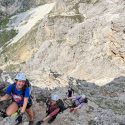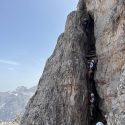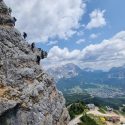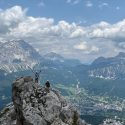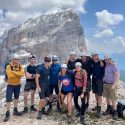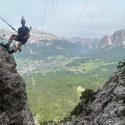Between 17-23 June, 8 students and 2 instructors from the Northumbrian Universities Air Squadron completed a series of progressively harder hikes, climbs and scrambles across challenging via ferrata routes located in the North, Central and East ranges of the Italian Dolomites. The six different via ferrata completed put our mental and physical resilience to the test in a unique and unfamiliar environment, with strong military links.
Via ferrata translates to ‘iron path’ in English, referring the fixed metal safety wire, metal rungs and ladders used as a means for crossing steep and rocky mountainous terrain, which would otherwise be inaccessible to unexperienced climbers or larger groups. Via ferrata originated in World War 1 and were constructed to aid the movement of troops and equipment into strategic mountain positions. Nowadays, via ferrata offer a kind of ‘safety net’ which enables more people to appreciate the Dolomites and their WW1 history whilst undertaking a physically and mentally exerting challenge thousands of metres up a sheer rockface. To make route selection easier the via ferrata routes are difficulty rated using the Fletcher Smith System. The first part is a number from 1 (easy) to 5 (difficult) and then for their ‘alpine commitment’ or ‘seriousness’ denoting a further aspect of difficulty and the remoteness and length of the route, rated from a (least commitment) to c (most commitment).
None of the group had any via ferrata experience, and the majority had very little climbing experience. Therefore, our first day consisted firstly of learning how to effectively use and attach our via ferrata rigs to our climbing harnesses and to the via ferrata itself. Via ferrata rigs were attached at one end to our climbing harnesses and at the other end consisted of two ropes with a carabiner at each end used to attach to the steel cable of the via ferrata. When used correctly these rigs prevent any serious or fatal falls to the foot of the rockfaces hundreds of metres below.
Our first ascent, a 3A, began slowly, with the team learning some basic climbing skills and getting used to detaching and reattaching each carabiner, one at a time, around the struts spaced every 2-3 metres along the via ferrata wire. We all began slightly nervously but as we gained height from our start point at an altitude of 2155m, the confidence in our ability grew and our climbing using the via ferrata became steadily faster and more efficient. After completing our second 1B rated route within 3.5 hours we had climbed over 430m and reached our highest altitude, 2472m.
Day 2 saw the basics we had learnt, tested with a greater ascent of 470m and 3B route. The route enabled a visual appreciation of the history of the via ferrata and WW1 with views over the ruins of the WW1 military hospital. After travelling down from the via ferrata via footpaths we hiked back up to the Lagazoui peak at 2751m. Travelling through the hundreds of metres of dark and damp passageway dug by the Italians upwards through the Lagazoui mountain in order to bomb the Austrians from underneath offered a more physical introduction to the WW1 military history of the Dolomites.
Day 3 provided us with a longer and more exposed route than the previous days, rated a 3B but with a more noticeable drop of hundreds of metres below us and an ascent of 950m. We remained composed throughout, trusting our newly found climbing abilities to reach an altitude of 2240m. The descent from the peak offered a new challenge: The steep slope made up of loose scree material allowed us all to learn a new skill, scrambling along the unsteady and ever-moving rock. The longer route taught the team the need to account for the weather and the need to pack effectively as a few people began to run out of water towards the end of the route due to the hot weather and longer route.
On day 4 we travelled North to the Tre Cime, or three peaks, which are very distinctive mountains that protrude from the surrounding landscape. In WW1 the Tre Cime marked the border between Italy and Austria-Hungary, hence the construction of the nearby via ferrata. The 3B route we climbed consisted of a greater number of ladders and overhanging sections, with remnants of the old wooden ladders from WW1 visible at points. We were particularly challenged by sections of the route where ladders were used to form inclining bridges across gaps between sections of separate rock faces with large empty drops of hundreds of metres below.
Day 5 offered our final and greatest challenge, with a 5C, a difficult and more remote via ferrata. This route was higher and felt far more exposed, with more technical climbing required due to a greater number of short overhanging sections and prolonged periods of climbing. The determination to complete the climb was tangible throughout the ascent, as we were all quieter and more focused, but still with plenty of encouragement and communication particularly on the harder sections. The whole team reached the summit after 650m of ascent and agreed upon this via ferrata being the hardest and most technical climb so far. We all felt accomplished and appreciated unanimously that it had been the best and most rewarding route.
Ex Via Dolomite was a successful expedition which enabled us to experience climbing in an extreme environment that, without the via ferrata, would have been far too technical and dangerous for us to attempt to climb. This challenging mountainous environment, particularly when at heights of thousands of metres, allowed us to test our ability to stay calm and make well-judged decisions whilst under both mental and physical stress. Throughout the trip we developed our resilience, communication, camaraderie and in particular teamwork, which helped to overcome the personal challenges that we each experienced throughout the week. One member of the group, whose first experience climbing was the via ferrata, said, “teamwork and always checking up on each other helped me to see the humorous side and to quickly start enjoying the hard physical experience” provided by the via ferrata. Throughout the week we also developed our navigational, climbing and scrambling ability. Overall, the expedition was a unique and fantastic experience which left all members of the group with a huge sense of achievement at having completed all the incredible routes planned.

